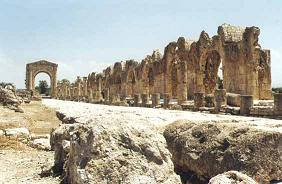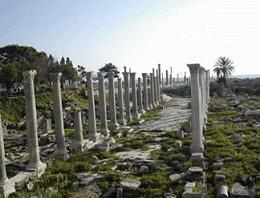Tyre Profile Altitude: 10m
Distance from Beirut: 83km
Getting there
From Beirut, take Khalde Highway South passing through Khalde, Damour, Naame, Saadiat, along the beautiful coast of the Mediterranean sea,
Saidon, Ghazieh, Sarafand, Adloun,
Tyre. |
 |
General
Information
Tyre
is a beautiful town on the shore of the Mediterranean Sea.
It is located at the meeting point of three continents and, as such, has
been the crossroads of many civilizations whose traces may still be seen
today.
Tyre was a major Phoenician seaport from about 2000 BC onwards through the
Roman period.
Tyre, built on an island and the neighboring mainland, was
probably originally founded as a colony of Sidon to the north and was
mentioned in Egyptian records of the 14th century BC as being subject to
Egypt. It became independent when Egyptian influence in Phoenicia declined and
soon surpassed Sidon as a trade centre, developing commercial relations with
all parts of the Mediterranean world. In the 9th century BC colonists from
Tyre founded in northern Africa the city of Carthage, which later became
Rome's principal rival in the West. The town is frequently mentioned in the
Bible as having had close ties with Israel. Hiram, King of Tyre, furnished
building materials for
Solomon's Temple in Jerusalem (10th century), and the notorious
Jezebel, wife of King Ahab, was the daughter of Ethbaal "King of Tyre and
Sidon." In the 10th and 9th centuries Tyre probably enjoyed some primacy over
the other cities of Phoenicia and was ruled by kings whose power was limited
by a merchant oligarchy.
For
much of the 8th and 7th centuries the town was subject to Assyria, and in
585-573 it successfully withstood a prolonged siege by the Babylonian King
Nebuchadrezzar II. Between 538 and 332 it was ruled by the Achaemenian Kings
of Persia. In this period it lost its hegemony in Phoenicia but continued to
flourish.
Probably the most famous episode in the history of Tyre was its resistance to
the army of the Macedonian conqueror, Alexander the Great, who took it after a
seven-month siege in 332, using floating batteries and building a causeway to
gain access to the island. After its capture, 10,000 of the inhabitants were
put to death, and 30,000 were sold into slavery. Alexander's causeway, which
was never removed, converted the island into a peninsula.
Tyre
was subsequently under the influence of Ptolemaic Egypt and in 200 became
part of the Hellenistic Seleucid kingdom; it finally came under
Roman rule in 68 BC. It was often mentioned in the New Testament and was
famous in Roman times for its silk products and for a purple dye extracted
from snails of the genus Murex. By the 2nd century AD it had a sizable
Christian community, and the Christian scholar Origen was buried there (c.
254).
 |
. |
Under Muslim rule from 638 to 1124, Tyre grew prosperous as part of the
kingdom of Jerusalem, a crusader state in the 12th and 13th centuries. The
Holy Roman emperor Frederick I Barbarossa, who died on the Third Crusade,
was buried in its cathedral (1190).
Captured and destroyed by the Muslim Mamluks in 1291, the town never
recovered its former importance. |
The silted up harbor on the south side of the peninsula has
been excavated by the French Institute for Archaeology in the Near East, but
most of the remains of the Phoenician period still lie beneath the present
town.
Tyre was built in ancient times on a small rocky island near
the coast. In the 10th century BC, King Kiram of Tyre constructed two ports
and a temple on the mainland sector of the city. This was the era when the
famous industries of Phoenician glass and purple dye were developed.
 |
|
Behind the walls of the old city the Tyrians successfully
defied Nebuchadnezzar for 13 years. Alexander the Great also laid siege to it
for 7 months, finally overwhelming the island city by constructing a great
causeway from the shore to the island. Over the centuries, however, the
causeway was silted up, turning Tyre into an isthmus. In biblical times it was
in Qana (Cana) near Tyre that Jesus turned water into wine at the wedding
feast. |
Behind the walls of the old city the Tyrians successfully
defied Nebuchadnezzar for 13 years. Alexander the Great also laid siege to it
for 7 months, finally overwhelming the island city by constructing a great
causeway from the shore to the island. Over the centuries, however, the
causeway was silted up, turning Tyre into an isthmus. In biblical times it was
in Qana (Cana) near Tyre that Jesus turned water into wine at the wedding
feast.
In 1980, modern Tyre's impressive Roman and Phoenician remains
prompted UNESCO to make the town one of its world heritage sites.
Information From the Ministry of
Tourism

|